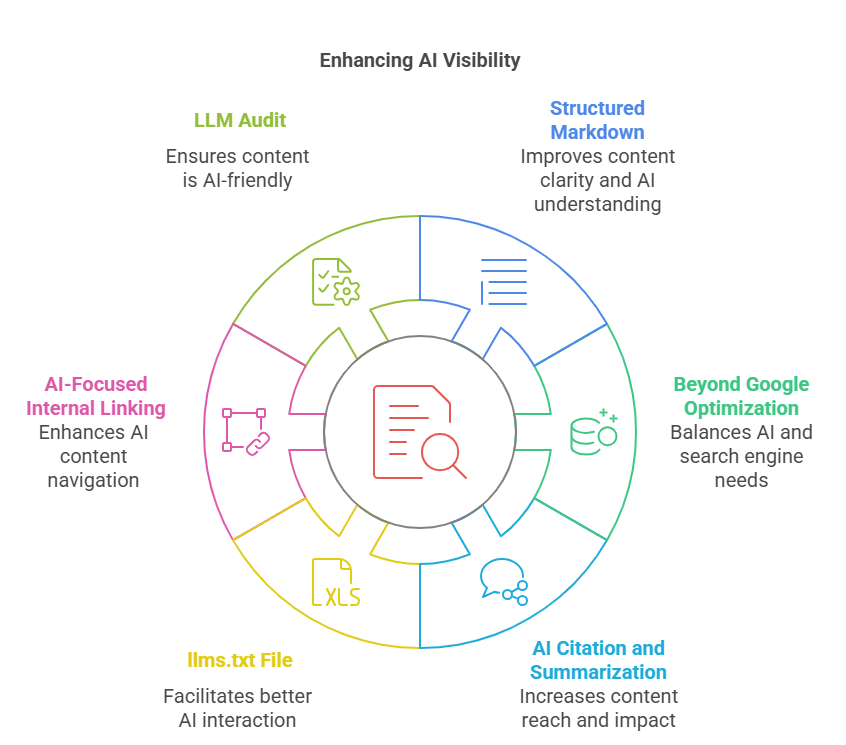Picture this: you pop a question into ChatGPT, and the answer comes from five of your rivals none of them are you. That tiny gut punch is the new reality of content discovery. Large language models (LLMs) are fast becoming the first (and sometimes only) stop for busy buyers who want a quick, trusted summary. If your pages aren’t showing up in those AI responses, you’re handing mindshare and pipeline to someone else, losing out on potential LLM-ready content opportunities.
Below is a practical, slightly urgent field guide to help you spot whether your site is invisible to LLMs and how to fix it before the next board meeting.
The Rise of LLM‑Ready Content: Why This Isn’t Just Another SEO Buzzword

What Does “LLM‑Ready” Really Mean?
LLM‑ready content is material that an AI model can parse, chunk, and cite without guesswork. Think clean markdown, logical headings, tight context, and links that paint a story instead of a keyword list. Traditional SEO chases rankings. LLMO (large language model optimization) chases citation and summarizability.
Example: A Google‑centric blog about “endpoint protection” might rank well thanks to backlinks and meta tags, especially if it includes llm-ready content. Convert that same piece into a structured markdown with crystal‑clear sub‑topics, and ChatGPT can quote the exact section on “zero‑day threats” in a heartbeat.
Why CMOs Should Care About Visibility in Generative AI
- 58.5 percent of US Google searches already end in a zero‑click result the user never visits a website because an answer snippet satisfies them.
- Google’s AI Overviews now appear in one‑third of tracked keywords, thanks to optimized web data strategies.
- Bain & Co. reports that 80 percent of consumers rely on zero‑click answers for at least 40 percent of their searches, cutting organic traffic by up to 25 percent.
If you depend only on classic SEO, you’ll watch traffic flatten while AI tools serve your prospects someone else’s wisdom.
Traditional SEO vs. AI Discoverability
| Factor | Traditional SEO | LLMO |
| Goal | Rank on SERP | Get cited in AI answers |
| Format focus | HTML, meta tags, schema | Markdown, plain‑text chunks |
| Crawlers | Googlebot, Bingbot | Firecrawl, custom RAG pipelines |
| Signals | Backlinks, CTR, dwell time | Context clarity, token efficiency |
| File helpers | robots.txt, sitemap.xml | llms.txt (AI’s roadmap) |
7 Signs Your Content Might Be Invisible to LLM-ready

Skim this list with your team. If you nod “yes” to three or more, it’s time for an LLMO audit.
1. Your Website Doesn’t Use Structured Markdown Formats
Open-source crawlers like Firecrawl chew through markdown with ease, drop the same content inside the nested soup, and token budgets explode, impacting platform performance when scraping entire websites. Convert one legacy HTML article to markdown, push it through ChatGPT, and watch answer quality jump.
Pro tip: Prepare your content for web scraping to maximize efficiency. Park a markdown version of every cornerstone post in a public GitHub repo. LLMs love raw files, especially when they are scraped from entire websites.
2. You’re Still Optimizing Solely for Google’s Algorithm
Ranking in Google is great. However, ChatGPT never mentions many high-rankers because the content lacks tight semantic framing. Run a side‑by‑side test: ask Perplexity for “best endpoint protection tools.” If your brand is absent while you own page one on Google, you’ve found the gap.
3. Your Content Isn’t Being Cited or Summarized by AI Tools
Quick test:
- Ask ChatGPT a question your blog answers.
- Add “include sources” at the end.
- Scan the citations for structured data that can enhance your content’s llm-readiness.
No mention? That’s a red flag. A free Chrome add‑on like ChatGPT Answer Check The API automates this experiment across multiple prompts, streamlining the process of generating LLM-ready data.
4. You’re Missing an llms.txt File
llms.txt is like robots.txt for AIs. Firecrawl’s generator can create one in minutes. List clean markdown URLs, block fluff, and hand LLMs a VIP map to your best insights from web data.
5. Your Internal Linking Is Built for Humans, Not LLMs
LLMs follow context threads, not menu breadcrumbs, making them ideal for processing LLM-ready data. Create “LLM hubs” pages that weave glossary terms, how‑tos, and data tables into a tight cluster. Retrieval-augmented generation (RAG) systems reward that structure by utilizing clean data from the web effectively.
6. AI Tools Struggle to Parse Your Content
Symptoms: heavy JavaScript, massive tables, iframes, PDFs, and poorly optimized web content. Fixes: export key assets to markdown, use html2markdown: Turn any website into LLM-ready content using html2markdown. Or Pandoc, which can host a raw version alongside the styled page.
7. Your Blog Hasn’t Been Audited for LLM Visibility Ever
An LLMO audit checks format, readability, entity clarity, markdown output, and real-world prompt tests as indicators of quality. Until you run one, you’re guessing.
How to Instantly Make Your Site More LLM‑Ready
Quick Wins Checklist
| Action | Description | Tool |
| Convert blogs to markdown | Cleaner parsing for any language model | Pandoc |
| Add llms.txt | Point AIs at the right URLs | Firecrawl |
| Test visibility in ChatGPT | Manual prompt testing | Custom GPT |
| Build topic clusters | Semantic link webs | Internal links |
| Add FAQ in markdown | Boosts summarizability | Yoast FAQ block |
Tools to Optimize Content for LLMs
- Firecrawl: Crawl and convert an entire site into llm‑ready data.
- Html2markdown: One‑line Python script to strip HTML.
- LlamaIndex + LangChain: Chunk and embed content for RAG demos.
- ChatGPT Visibility Tester: A prompt bank that flags missing citations.
- LLMO Auditing Templates: Spreadsheet to score every URL (grab it behind a simple email gate).
What LLMs Actually Like: Real Examples

- Before vs. After: Show an unstructured HTML block, then the same text in a structured markdown. Token count drops by 40 percent, and answer accuracy spikes, especially when using structured data in your llm-ready content.
- SEO keywords vs semantic context: Replace a keyword‑stuffed paragraph with a concise explainer and watch ChatGPT quote it verbatim, transforming it into llm-ready content.
- With vs. Without llms.txt: Firecrawl log shows crawl depth doubled when llms.txt guided the bot.
Conclusion: Don’t Just Optimize for Search, Optimize for the Future of Answers
Zero‑click searches are already the norm, and AI summaries are spreading fast. CMOs know generative AI is a top priority 78 percent are optimistic about its upside yet 27 percent admit their teams still haven’t adopted it. Being visible in AI answers is the new moat. Start with markdown, map your llms.txt, test real prompts, and you’ll show up where tomorrow’s buyers are already looking for web content.
FAQ for Long‑Tail LLMO Queries
What is LLMO in content marketing?
Large language model optimization is the art of shaping pages so AIs can parse, understand, and surface them in answers on ChatGPT, Perplexity, Gemini, and future tools.
How do I know if my blog is LLM‑ready?
Prompt test it. Check formatting. Look for markdown, smart internal links, and a live llms.txt. If those pieces are missing, the odds are LLMs skip you.
Can I make existing blogs LLM‑ready without rewriting everything?
Yes. Convert to markdown, chunk semantically, add missing context, and update metadata to meet the web’s new LLM-ready content standard. Often, it’s a formatting project, not a full rewrite, especially when preparing data sources.
Will being LLM‑ready help with traditional SEO?
Indirectly. Cleaner structure improves snippet eligibility, voice search, and dwell time for LLM-optimized content. What helps AIs parse usually helps humans read.
